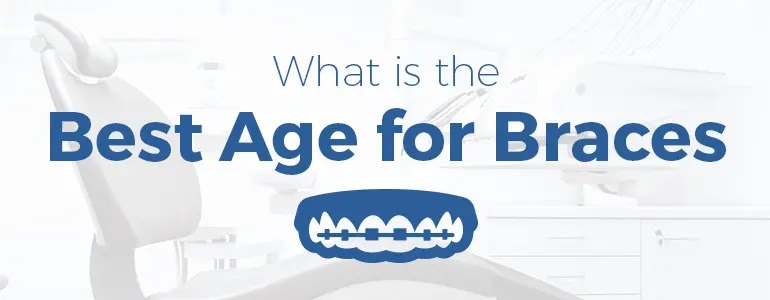
People are more confident and can communicate better when they know their teeth look healthy and straight.
Braces are an important part of helping teeth grow the right way. If teeth grow in at odd angles, it can be painful and difficult to speak and chew. Braces slowly straighten out the teeth and move them, so they’re not pushing or grinding against each other.
When overbites occur or crooked teeth grow in, you know braces could help your child, but you might not know where to start.
Consider these questions when getting braces for your child:
Learning the answers to these questions, and understanding more about the different stages your teeth go through as you age, can help you determine what the best age is to get braces.
At AZ Family Dental, we have helped people of many ages with their braces. Read on to learn more about the process and how you can decide when to get your child’s teeth straightened.
Each person is different, so there isn’t a go-to age to get braces. When asking if it’s the right time for braces, you need to know the status of the teeth in the mouth.
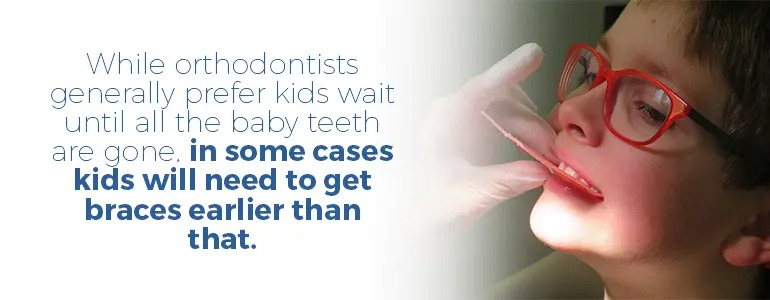
There are two types of teeth we may ask about when you come to our office to discuss getting braces:
Again, there’s no one-size-fits-all answer to this question. While orthodontists generally prefer kids wait until all the baby teeth are gone, in some cases kids will need to get braces earlier than that, to address issues such as overcrowding of teeth, severe under- or overbites, or abnormal growth of the jaw.
In these cases, getting braces can help clear the way in the mouth for the permanent teeth to come in safely and with enough spaces. That’s why you can see braces in patients 10 years old or even younger.
Remember that your child is an important part of the decision regarding when to get braces. While they don’t have the final say, you should give them a chance to voice their concerns. Many children are self-conscious about getting braces.
Adolescence is a sensitive time, and this is a direct change in their appearance. You can reassure them by explaining:
When your children have their 12-year molars and have lost their primary teeth, they’re usually around ages 12 and 13. After consulting with an orthodontist, you’ll know if this is the appropriate age for your child to get braces.
Braces aren’t only for children and teenagers, however. If you’re an adult and your family couldn’t afford to get you braces as a child — or didn’t know you needed them, or you did get braces but didn’t follow up with your retainers — you can still get braces as an adult.
There isn’t an age limit for braces!
Braces align the teeth and mouth so after treatment you can enjoy life with straight teeth and a jaw that doesn’t cause any pain or trouble. Braces also actively fix problems maligned jaws and crooked teeth cause. They protect your mouth and help your jaw form correctly.
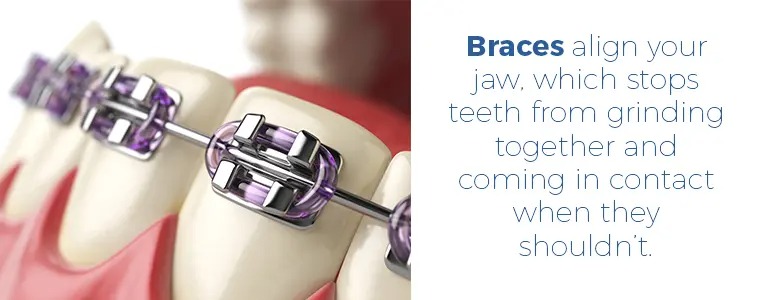
According to MouthHealthy.org, getting braces can help with the following conditions:
When you know your mouth is healthy and you have a beautiful smile, the added psychological benefits help your identity and presentation. Advantages of having braces for kids and adults can include:
While you might think there is only one choice for braces, your child has options. There are four main types of braces to choose from, and each comes with their pros and cons.
These are the traditional braces most people are familiar with. While they tend to be cheaper and come in different colors so children can pick what they want, they are also the most obvious type of braces. If your child wants something that’s more subtle, you might consider exploring other options.
Like metal braces, ceramic braces go on the outside of teeth. The brackets are camouflaged white to match the teeth. These are more expensive than metal braces and need to be taken care of so they don’t stain.
These are built like metal braces but go on the inside of teeth so they’re less noticeable. While this is the main attraction to these braces, they come with their difficulties. Lingual braces are tricky to clean and more expensive. They also don’t work for cases in which the teeth are unusually out of line.
Plastic aligners are custom-made for the mouth, and the patient gets new ones every two weeks. These are nearly invisible, and they lack the eating and drinking restrictions that come other types of metal braces. However, these work only on mildly out-of-line teeth and are expensive. They could take longer to align teeth than traditional braces.
When your child gets braces, you’ll have a treatment plan detailing how long they’ll need braces and care after you’ve had them taken off.
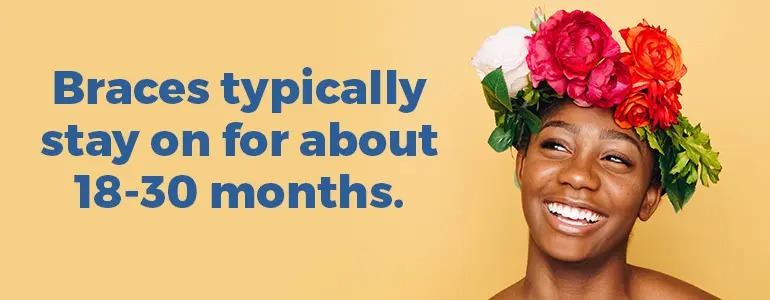
For metal and ceramic braces, it takes about two hours to apply. After cleaning the teeth, your orthodontist will put bonding glue on the teeth and attach the brackets. Then the wire will be placed on the brackets and set with rubber bands.
Your child will regularly visit the orthodontist for check-ups and to get the braces tightened. This helps keep your teeth moving in the right direction.
While this process doesn’t cause a lot of pain, it can cause soreness. Using ice packs and consuming cold food and drinks can help ease the sensation. Rinsing the mouth with warm water mixed with salt can also reduce pain. Remember, the sore feeling won’t last forever. The mouth just needs time to adjust to the braces.
Feeling discomfort in teeth with braces is common. While this will probably go away quickly, your child has the option of taking painkillers like ibuprofen.
Brushing and flossing your children’s teeth regularly will keep them clean, healthy, and prevent cavities. They will need to brush and floss thoroughly but softly, so they don’t ruin their braces.
Since food particles can get stuck in braces, your child should brush and floss after every meal. They should have a soft toothbrush and make sure their toothpaste contains fluoride.
If your child has a habit of chewing on pens and pencils or biting their nails, try to break that habit quickly, because that could also damage the braces. Sometimes accidents do happen and wires snap or brackets become loose. If this happens, schedule an appointment with the orthodontist to get them fixed as fast as possible.
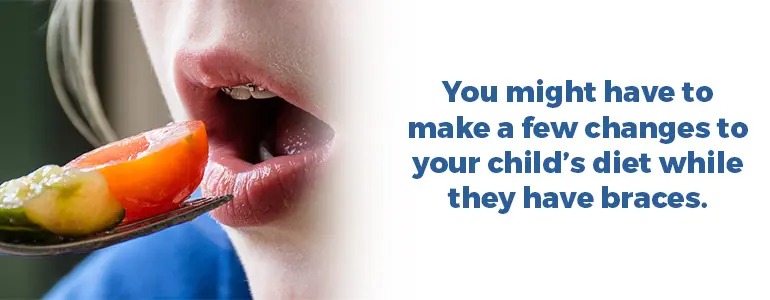
You might have to make a few changes to your child’s diet while they have braces. Many types of food could potentially mess up the braces. It’s best to avoid these foods entirely. This will keep your child’s mouth safe and keep them on the treatment plan to having a perfect smile as soon as possible. Avoid the following:
There are still plenty of delicious foods your child can eat with braces. They tend to be softer and are typically more nutritious than the foods you should avoid.
After first getting braces, your child will find eating only soft foods will be the best option. Foods like yogurt and applesauce will be the easiest to handle the first week with braces.
When your child’s braces get taken off, they’ll still have to take care of their teeth to make sure they stay straight. Most people get a retainer to keep their teeth in place. There isn’t a general guideline for how long you’ll need the retainer because it’s different for everyone.
Retainers have their own set of rules, like braces. While you don’t have to worry about wires snapping or brackets coming loose, your child still has to take care of their retainer to keep their teeth and mouth as healthy as possible, keeping in mind the following precautions:
Also remember, the retainer should come with your child to their orthodontist appointments.
Braces are an important step to giving your child the perfect smile that will give them confidence and high self-esteem. We’ll help your family start that journey by advising you on what is the best age for braces for your children.